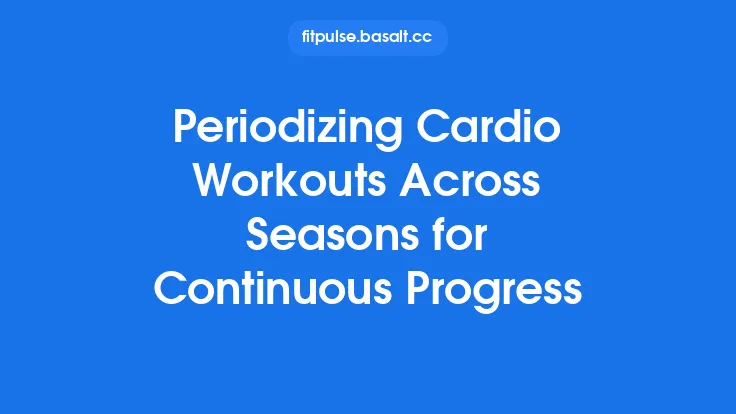When you train with just a pull‑up bar, a set of resistance bands, a pair of parallettes, or even a simple weighted vest, the biggest advantage is flexibility: you can work out anywhere, anytime, and you’re not limited by a bulky gym‑membership. That flexibility, however, can become a double‑edged sword if you never step back to look at the bigger picture. Without a structured plan, it’s easy to fall into the “do‑more‑of‑the‑same” trap, plateau, or even regress due to overuse injuries.
Periodization is the science‑backed method of organizing training variables—volume, intensity, frequency, and exercise selection—into systematic phases that promote continual adaptation while managing fatigue. Applying periodization to minimal‑equipment calisthenics lets you harness the simplicity of bodyweight movements while still delivering the progressive overload needed for long‑term strength, hypertrophy, skill, and mobility gains. Below, we’ll walk through the core concepts, the most effective periodization models for a minimal‑gear toolbox, and practical steps to build a sustainable, lifelong program.
Understanding the Foundations of Periodization
1. The Training Variables
| Variable | Definition | Typical Manipulation in Calisthenics |
|---|---|---|
| Volume | Total work performed (sets × reps × load). | Adjusting set counts, rep schemes, or adding extra bodyweight variations. |
| Intensity | Relative load per rep (percentage of maximal effort). | Moving from assisted to unassisted movements, adding external weight, or increasing band tension. |
| Frequency | How often a movement or muscle group is trained per week. | Scheduling multiple pull‑up sessions, or rotating push‑pull‑leg days. |
| Exercise Selection | Specific movements performed. | Swapping standard push‑ups for archer push‑ups, or using rings for rows. |
A well‑designed periodized plan deliberately varies these variables over time, ensuring that each training stimulus is novel enough to provoke adaptation while also allowing sufficient recovery.
2. The Adaptation Cycle
- Stress (Training Stimulus) – The body experiences mechanical tension, metabolic stress, and neural demand.
- Recovery (Supercompensation) – During rest, the body repairs and strengthens the stressed tissues.
- Performance Gain – If the next training session occurs at the right point in the recovery window, performance improves.
- Diminishing Returns – Repeating the same stimulus without variation leads to a plateau.
Periodization orchestrates this cycle by timing the introduction of new stresses and strategically inserting recovery phases.
Choosing a Periodization Model for Minimal‑Equipment Calisthenics
Linear (Classic) Periodization
- Structure: Gradual increase in intensity (e.g., from high‑rep assisted pull‑ups to low‑rep strict pull‑ups) while volume decreases.
- Typical Phases:
- Hypertrophy/Endurance (4–6 weeks): 3–4 sets of 12–20 reps, light assistance.
- Strength (3–4 weeks): 4–5 sets of 6–10 reps, moderate assistance or added weight.
- Power/Skill (2–3 weeks): 3–5 sets of 3–5 reps, near‑maximal effort, focus on explosive tempo or advanced variations.
- Pros: Simple to follow, clear progression, works well for beginners who need a predictable roadmap.
- Cons: May become monotonous for advanced athletes; less flexibility to respond to day‑to‑day readiness.
Undulating (Non‑Linear) Periodization
- Structure: Intensity and volume fluctuate within a week or even a single session.
- Example Weekly Layout:
- Monday (Heavy): 5×3 weighted chin‑ups (85% 1RM).
- Wednesday (Moderate): 4×8 band‑assisted dips (50% assistance).
- Friday (Light/Skill): 3×10 hand‑stand holds, 4×12 scapular pull‑ups.
- Pros: Keeps training stimulus varied, reduces monotony, better suited for athletes with fluctuating schedules.
- Cons: Requires more careful tracking of load and fatigue; may be confusing for novices.
Block Periodization
- Structure: Focuses on a single training quality per “block” (e.g., strength block, skill block) before moving to the next.
- Typical Block Length: 3–5 weeks, followed by a deload week.
- Application Example:
- Block 1 – Strength: Emphasize weighted pull‑ups, weighted dips, and weighted pistol squats.
- Block 2 – Skill: Shift to planche progressions, front‑lever holds, and advanced hand‑stand work, reducing external load.
- Block 3 – Hypertrophy/Conditioning: Incorporate higher‑rep circuits with bands and bodyweight complexes.
- Pros: Allows deep focus on a specific adaptation, ideal for mastering complex calisthenics skills.
- Cons: Longer periods of high intensity can increase injury risk if recovery is neglected.
Hybrid Approaches
Many athletes blend models—using a linear macrocycle (e.g., 12‑week program) while employing undulating microcycles within each mesocycle. The hybrid approach offers the clarity of linear progression with the variability needed to keep the nervous system responsive.
Designing a Periodized Macrocycle with Minimal Gear
Below is a step‑by‑step framework that can be adapted to any of the models above. The example assumes a 24‑week (≈6‑month) macrocycle, which is a realistic horizon for measurable long‑term progress.
Step 1: Define Your Primary Goals
| Goal | Primary Variable to Manipulate | Example Metric |
|---|---|---|
| Strength | Intensity (load) | Weighted pull‑up max (kg) |
| Hypertrophy | Volume | Total weekly reps of push‑ups |
| Skill | Technique & neuromuscular control | Time held in a tuck planche |
| Conditioning | Metabolic stress | Number of rounds completed in a 20‑min AMRAP |
You can prioritize one primary goal while maintaining secondary goals (e.g., strength focus with a secondary skill component).
Step 2: Break the Macrocycle into Mesocycles
| Mesocycle | Length | Focus | Typical Rep Scheme |
|---|---|---|---|
| Foundation (4 weeks) | 4 | Build work capacity, perfect movement patterns | 3–4 sets of 12–15 reps, light assistance |
| Strength Build (6 weeks) | 6 | Increase load, lower rep ranges | 4–5 sets of 4–8 reps, added weight or reduced band assistance |
| Skill Integration (4 weeks) | 4 | Introduce advanced variations, maintain strength | 3–5 sets of 3–6 reps + skill practice (e.g., planche leans) |
| Hypertrophy/Conditioning (4 weeks) | 4 | Higher volume, metabolic stress | 3–4 sets of 12–20 reps, supersets, short rest |
| Deload & Test (2 weeks) | 2 | Recovery, performance testing | 50 % volume, 70 % intensity; final 1RM and skill tests |
| Peak/Performance (4 weeks) | 4 | Consolidate gains, peak for a challenge (e.g., 10‑rep weighted pull‑up) | Specific tapering, high intensity, low volume |
Step 3: Assign Microcycles (Weekly Plans)
Within each mesocycle, decide on a weekly template. A common 4‑day split works well with limited equipment:
| Day | Primary Movement | Secondary/Accessory | Volume/Intensity Guidance |
|---|---|---|---|
| Day 1 | Pull (Pull‑ups/Rows) | Core (L‑sit, hanging leg raises) | Heavy: 4–5 sets of 4–6 reps |
| Day 2 | Push (Dips/Push‑ups) | Mobility (Shoulder dislocates with band) | Moderate: 3–4 sets of 8–12 reps |
| Day 3 | Lower (Pistol Squats/Weighted Step‑ups) | Grip (Towel hangs) | Light/Skill: 3 sets of 10–15 reps + skill work |
| Day 4 | Full‑Body/Conditioning (Circuit) | Skill (Hand‑stand, planche) | Variable: 5‑minute EMOM or 20‑min AMRAP |
Adjust the order based on personal recovery patterns (e.g., if pull‑ups tax your forearms heavily, place a lower‑body day after).
Step 4: Program the Deload
Deload weeks are not “off” weeks; they are strategic reductions in stress to allow supercompensation. Two common methods:
- Volume‑Based Deload: Cut total sets by 40–50 % while keeping intensity (load) the same.
- Intensity‑Based Deload: Keep volume but reduce load to 60–70 % of the previous week’s intensity.
For minimal‑equipment calisthenics, a volume‑based deload is often more practical—perform fewer sets of the same bodyweight or assisted movements.
Step 5: Testing and Re‑Calibration
At the end of each macrocycle, schedule a performance test aligned with your primary goal:
- Strength: 1RM or 5RM weighted pull‑up, weighted dip, or weighted pistol squat.
- Hypertrophy: Take circumference measurements or use a standardized “max reps in 2 minutes” test.
- Skill: Record hold times for planche, front lever, or hand‑stand.
Use the results to set new training loads for the next macrocycle, ensuring progressive overload continues.
Practical Progression Strategies for Minimal Gear
Even with limited equipment, you can create a near‑infinite ladder of difficulty. Below are proven progression techniques that fit neatly into a periodized framework.
1. Assistance Manipulation
- Bands: Vary thickness or anchor point to change the percentage of bodyweight supported.
- Foot Placement: For dips, place feet on a raised surface to reduce load; for pull‑ups, use a chair to assist.
- Partial Range of Motion: Start with “quarter‑rep” pull‑ups, then expand to half‑rep, then full‑rep.
2. External Load Addition
- Weighted Vest or Backpack: Add 5 % of bodyweight for strength blocks; increase by 2.5 % each mesocycle.
- Ankle Weights: Useful for lower‑body progressions (pistol squats, Nordic curls).
3. Tempo Manipulation
- Eccentric Emphasis: 3–5 seconds lowering phase, 1 second pause, explosive concentric. Great for hypertrophy and strength.
- Isometric Holds: Pause at the bottom of a dip or pull‑up for 2–3 seconds to increase time under tension.
4. Complexes and Supersets
- Pair opposing movements (e.g., pull‑up → push‑up) with minimal rest to boost metabolic stress without needing extra equipment.
- Use “skill‑strength” complexes: 3 × 5 weighted pull‑ups → 5 × 5 planche leans → 3 × 5 weighted dips.
5. Skill‑Specific Drills
- Progressive Leans: For planche or front lever, start with a lean on parallettes, then increase the angle.
- Wall‑Supported Hand‑Stand: Begin with wall walks, progress to freestanding holds as balance improves.
These micro‑progressions can be slotted into any phase—light phases emphasize skill and technique, heavy phases prioritize load, and hypertrophy phases focus on volume and tempo.
Managing Fatigue and Recovery in a Minimal‑Gear Context
Even though you’re not loading a barbell, calisthenics can generate substantial neuromuscular fatigue, especially when using high‑intensity variations. Here are evidence‑based recovery tactics that complement periodization:
- Sleep Hygiene: Aim for 7–9 hours of consolidated sleep; prioritize a consistent bedtime to support hormonal recovery.
- Active Recovery Sessions: Light mobility circuits, band‑assisted shoulder dislocates, or low‑intensity yoga can enhance blood flow without adding stress.
- Nutrition Timing (Brief Note): While a full nutrition article is out of scope, ensure a protein‑rich meal within 2 hours post‑workout to aid muscle repair.
- Auto‑Regulation Tools: Use a simple “RPE” (Rate of Perceived Exertion) scale (1–10) to adjust set counts on the fly. If a session feels >8 RPE consistently, consider dropping volume or adding a deload.
- Joint Health: Incorporate scapular activation drills and wrist mobility work at the start of each session to reduce overuse strain.
By integrating these recovery principles into each mesocycle, you safeguard against the chronic fatigue that often derails long‑term progress.
Common Pitfalls and How to Avoid Them
| Pitfall | Why It Happens | Countermeasure |
|---|---|---|
| Stagnant Rep Schemes | Relying on the same 10‑rep set for months. | Rotate rep ranges every mesocycle (e.g., 12‑15 → 6‑8 → 3‑5). |
| Neglecting Skill Work | Focusing solely on strength numbers. | Allocate at least 10–15 % of weekly volume to skill drills, even during strength blocks. |
| Over‑Assisting | Using bands that make movements too easy, limiting tension. | Periodically test with reduced assistance to gauge true strength. |
| Skipping Deloads | Believing “no pain, no gain.” | Schedule a deload every 4–6 weeks; treat it as a non‑negotiable training session. |
| Ignoring Mobility | Tight shoulders or hips limit range of motion. | Include a 5‑minute mobility warm‑up and a 5‑minute cool‑down each session. |
| All‑Or‑Nothing Mindset | Missing a session leads to “I’m off the plan.” | Use the periodized template as a guide, not a rigid rule; adjust on the fly using RPE. |
Sample 8‑Week Microcycle (Undulating Model)
Below is a concrete illustration of how to embed the concepts discussed into a two‑month block. The example assumes access to a pull‑up bar, a set of resistance bands, and a weighted vest.
| Week | Monday (Heavy Pull) | Wednesday (Moderate Push) | Friday (Skill/Condition) |
|---|---|---|---|
| 1 | 5×3 weighted pull‑ups (85 % 1RM) <br> 3×8 band‑assisted rows (30 % assistance) | 4×6 weighted dips (10 % bodyweight) <br> 3×12 archer push‑ups (bodyweight) | 4×5 planche leans (30 s each) <br> 5‑minute EMOM: 5 × burpees |
| 2 | 4×5 weighted pull‑ups (80 % 1RM) <br> 3×10 band‑assisted rows (40 % assistance) | 5×8 weighted dips (5 % bodyweight) <br> 4×15 pseudo‑planche push‑ups | 3×8 hand‑stand wall walks <br> 4‑round AMRAP: 10 × band pull‑downs, 15 × jump squats |
| 3 | 3×6 weighted pull‑ups (75 % 1RM) <br> 4×12 band‑assisted rows (50 % assistance) | 3×10 weighted dips (bodyweight) <br> 3×20 incline push‑ups (feet elevated) | 5×5 tuck planche holds (45 s) <br> 6‑minute HIIT: 30 s on/30 s off (mountain climbers) |
| 4 (Deload) | 3×5 bodyweight pull‑ups (no weight) <br> 2×8 band rows (60 % assistance) | 2×8 bodyweight dips <br> 2×12 push‑ups | 3×30 s hand‑stand against wall <br> Light mobility circuit |
Notice the systematic reduction in volume during week 4, while intensity remains moderate. After the deload, you would either repeat the block with slightly higher loads or transition to a skill‑focused mesocycle.
Long‑Term Planning: From Year‑One to Year‑Three
A well‑structured periodized approach is not a one‑off program; it’s a roadmap that evolves as you gain strength, skill, and confidence.
| Year | Primary Focus | Typical Macrocycle Structure |
|---|---|---|
| Year 1 | Build foundational strength & movement patterns. | Linear progression with 4‑week hypertrophy blocks → 4‑week strength blocks → 2‑week deload. |
| Year 2 | Introduce advanced skills (planche, front lever) while maintaining strength. | Block periodization: 5‑week strength → 5‑week skill → 4‑week hypertrophy → 2‑week deload. |
| Year 3 | Optimize performance for specific challenges (e.g., 10 kg weighted pull‑up for 10 reps). | Undulating macrocycle with weekly micro‑variations, frequent testing, and strategic peaking phases. |
Each year, reassess your primary metrics, adjust training frequencies, and incorporate new equipment only if it serves a clear purpose (e.g., adding rings for a specific skill). The core principle remains: systematic variation + adequate recovery = sustainable progress.
Final Thoughts
Periodization transforms the simplicity of minimal‑equipment calisthenics into a powerful, science‑backed system for lifelong development. By deliberately manipulating volume, intensity, frequency, and exercise selection across macro‑, meso‑, and micro‑cycles, you can:
- Avoid plateaus through regular stimulus changes.
- Manage fatigue with built‑in deloads and auto‑regulation.
- Balance strength, hypertrophy, and skill without needing a full gym.
- Track meaningful progress via periodic testing aligned with your goals.
Start by mapping out a 12‑ to 24‑week macrocycle that reflects your current priorities, choose a periodization model that matches your personality and schedule, and embed the progression tools discussed here. With consistency, thoughtful variation, and respect for recovery, minimal‑gear calisthenics can keep you getting stronger, more skilled, and healthier for years to come.




